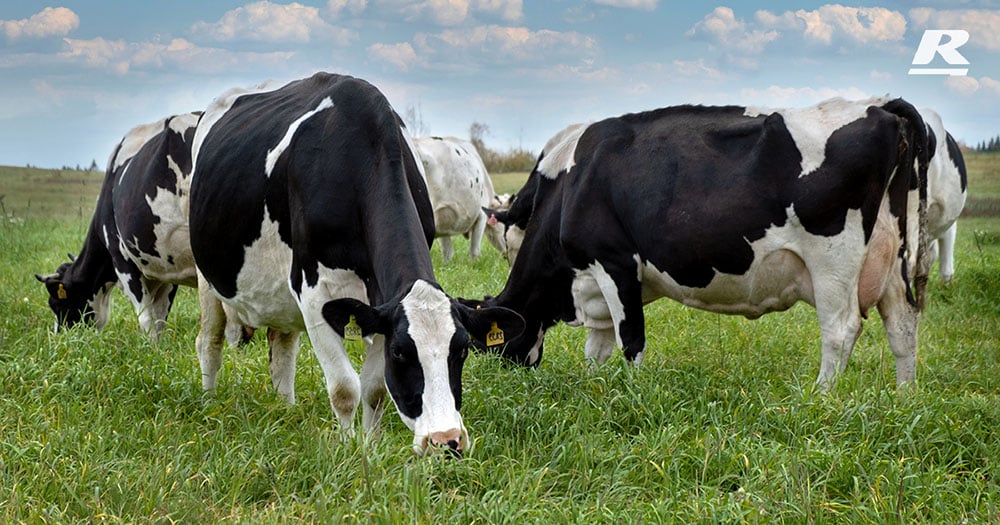Understanding Facial Eczema
Facial Eczema may sound like a disease of the skin but it is important to understand it is not. This disease can be quite detrimental to not only milk production but also the cow’s physical health. While outbreaks are commonly seen in Gippsland; outbreaks of Facial Eczema have been observed in other areas of Victoria as well as coastal areas of Australia.
So what is Facial Eczema?
Facial Eczema is a disease of the liver and bile duct that occurs when ruminants consume a toxic mycotoxin called sporidesmin, which is produced by the fungus Pithomyces Chartarum. The fungus Pithomyces Chartarum is predominantly found in ryegrass dominant pastures growing among dead trash litter or at the base of the pasture sward. Even though fungus spores can be found all year round, the hot and humid weather associated with late summer and autumn will create the environment for spores to rapidly multiply. This is where spore levels reach a danger zone and we see the sporidesmin toxin wreak havoc on ruminants.
Once ruminants have ingested the spores, sporidesmin is produced in the gastrointestinal (GI) tract, absorbed into the bloodstream and produces oxygen free radicals in the liver. This causes liver, bladder and mammary gland damage. The liver may lose some of its functioning, affecting waste removal from the body. Sporidesmin concentrates in the bile ducts causes necrosis and inhibits bile secretion. Chlorophyll is broken down in the rumen to phylloerythrin, which is normally absorbed into the blood and excreted in bile. However, if the bile ducts are blocked, circulating phylloerythrin reacts with UV light in the skin, causing photosensitisation. Blood serum levels of the enzyme gamma glutamyl transferase (GGT) give the best indication of the severity of liver and bile duct damage (serum GGT >700 IU/L indicates severe damage).
Signs/ Symptoms
It is important to conceptualise that not all animals affected with Facial Eczema will have signs or symptoms. According to Dairy NZ, “it is estimated that for every clinical case (physical signs) there will be 10 more cows with subclinical FE (no signs, liver damage). Clinical symptoms such as photosensitisation can take 10 to 14 days from after the ruminant has consumed infected pasture; meanwhile the damage has already occurred to the liver.
You may find that the following days after consuming the toxic pasture, the cows have a sudden burst of diarrehea but quickly returns to normal then a few days later, you may see a decent drop in milk production.
Other signs to monitor are:
- Cows becoming restless and irritable (cows won’t handle having cups on)
- Red teats, third eyelid and vulvas
- Redness in unpigmented skin
- Seeking shade
- Shows signs of heat stress
- Weight loss and reduced FCE
- Reproductive issues
- Skin lesions/sloughing
- Lameness
- Jaundice
Preventions
Prevention is key to reducing the risk of this disease, as there is no cure for Facial Eczema. Understanding pasture management, predicating toxicity periods and monitoring spore counts during summer and autumn can reduce the risk of feeding animals on contaminated pasture.
A proven solution to reduce the risk is short-term feeding (usually zinc oxide for up to 100 days) of 20mg elemental zinc per kg live weight per day. In Australia, the most effective way to cow feed is via a Zinc oxide supplement through a pellet/grain concentrate which will reduce the amount of clinical cases as well as the level of liver damage. Zinc Oxide will need to fed 2-3 weeks before the toxic period commences. It is strongly recommended that feeding Zinc Oxide after 2 weeks, 10 random cows have their blood tested to ensure the correct does of Zinc has gone in for their weight range. As a feed company, we are able to have the Zinc Oxide supplement in for 100 days, if you require the supplement to go in for longer, a vet will become involved to ensure the Zinc levels in the blood are still adequate. It is important to understand that feeding Zinc Oxide will not repair the liver once it has been damaged.
Other methods that are less common in Australia to provide Zinc oxide is through drinking water, oral drench and via bolus (dry cows/ heifers). The safest way to deliver the zinc is through the feed, which is what Reid’s can assist with.
Other preventions include:
- Spore monitoring ( Dairy Australia will start their programme in January but spores can differ from paddock to paddock)
- Do not graze hard into the residual of the plant during risk period. Better of leaving residual behind
- Do not allow cows to chew to the base; allocate more feed (silage/hay) to dilute the amount of pasture in the diet.
- Zinc Oxide in at the correct time and dose rate. Zinc oxide will not reverse any damage that has already occurred to the liver.
- Reduce topping in in summer to limit the amount of trash at the bottom of the plant.
Treatment
If you have animals affected by facial eczema, we recommend that you contact your vet ASAP for the correct medicated treatment pathway. In the meantime, Dairy Australia recommends:
- moving stock from any contaminated pasture
- Any cows affected, consider drying them off
- Move cows to a paddock or shed to provide a decent shading option away from the sun.
- Supply a high energy and protein diet balance diet including silage
It is very rare that affected animals will improve after having Facial Eczema as once the damage is done to the liver and bile duct it is irreversible.
Facial eczema is not a disease of the skin and it can affect all breeds; remember prevention is key.
To increase your livestock farming gains & expert nutritional feeding advice please call 1300 REID FEED or enquire here >
 Author
Author
Kate Phillips
Gippsland Territory Manager – Ruminant

 Author
Author